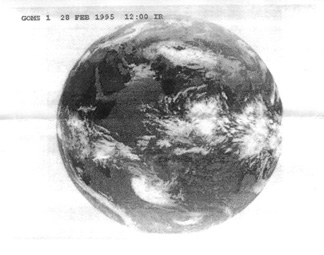

The European Space Agency (ESA) began a geosynchronous satellite
program (EurMetSat) in 1977 with Meteosat-1. All told, six Meteosats
have been placed in orbit. They sense in three spectral bands:
0.4 - 1.1 µm, 5.7 - 7.1 µm, and 10.5 - 12.5 µm. The top view below
is a Meteosat-6 visible image over western Europe made on April
28, 1997. Russia started a new geosynchronous weather satellite
program (GOMS) in 1995. The bottom image is a GOMS-1 thermal band image
over the Indian Ocean made on February 28, 1995.


Both India and Japan have been active in designing, building,
and launching metsats since the late 1970s. India's efforts began
with Bhaskara 1 (June 7, 1979). There has since been two series
(four each) of Insats (Insat-1A on April 10, 1988; Insat-2D in
1995), each with a visible and a thermal IR band; these are multi-purpose
satellites also dedicated to communications and broadcasting.
A representative Insat image (very few are available over the
Internet) covering eastern Africa and southern Asia is shown in
the top image. Japan commenced its GMS (Geostationary Meteorological
Satellite) program (Himawari series) on July 14, 1977, sponsored by its National
Space Development Agency (NASDA) both as an operational system
and as a contribution to the worldwide GARP (Global Atmospheric
Research Program) effort. Positioned at 140° E, the current member,
GMS-5, with a VISSR in the visible, thermal IR, and water vapor
band (6 µm), produces black and white individual full Earth views
and color composites like that shown on the bottom over the western
Pacific.


By combining images from GOES, Meteosat, and GMS, it is feasible
to construct almost real-time cloud distribution coverage of most
of the Earth's surface (exclusive of the poles), as reproduced
here in the visible for April 28, 1997:

Code 935, Goddard Space Flight Center, NASA
Written by: Nicholas M. Short, Sr. email: nmshort@epix.net
and
Jon Robinson email: Jon.W.Robinson.1@gsfc.nasa.gov
Webmaster: Bill Dickinson Jr. email: rstwebmaster@gsti.com
Web Production: Christiane Robinson, Terri Ho and Nannette Fekete
Updated: 1999.03.15.